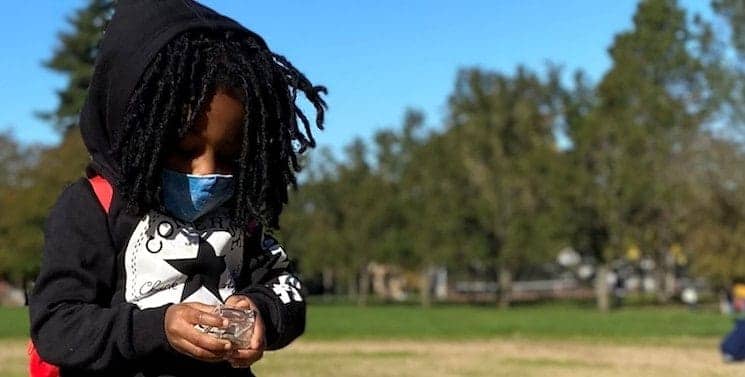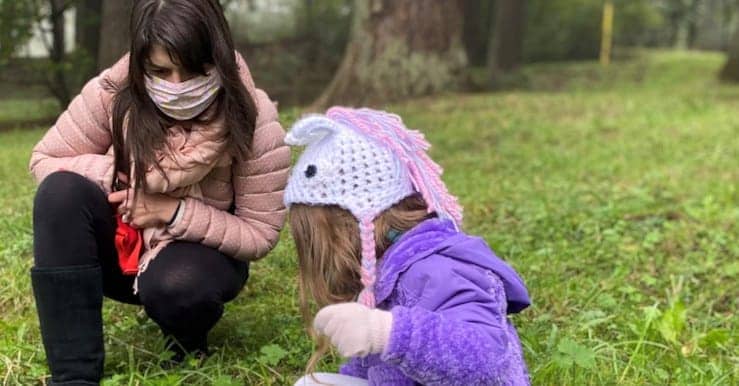
By Portland Parks & Recreation’s Environmental Education Team
During the winter months, some Portlanders may hunker down and move their lives indoors. But Portland Parks & Recreation’s Environmental Education (EE) team teaches outdoors, year-round, and we can tell you — children have a blast on even the coldest and rainiest days! With appropriate gear, an open mind, and a few good ideas for where to explore, families can easily enjoy the outdoors during the fall and winter months!
Portland Parks & Recreation is delighted to provide some suggestions on where you can explore, even in the middle of the city. Many PP&R parks have both open space and tree cover, nature patches (areas in PP&R parks designed for wildlife AND for exploration), dog off-leash areas, and inclusive playgrounds. Learn more about PP&R’s nature patches here or sign up to help plant one this winter.
Across the more than 11,000 acres of the Portland Parks & Recreation (PP&R) system, birds and animals continue their regular activities — as they do in all seasons! Look closely, nature’s critters that live in the Northwest have creative ways of staying warm and dry. Tall Douglas Fir trees offer thick cover and shelter from the rain. Sunny hillsides offer a warmer place to look for food and nesting materials. Hills (and even buildings) offer shelter from the winds.
Tips for Happy Fall and Winter Explorers
- For everyone: Wear multiple layers, hats and mittens, a raincoat, and boots or sturdy shoes.
- For children: Wear pajamas under pants to offer a warm layer, choose wool or synthetic socks, use plastic bags to help waterproof old boots that leak. Bring a full change of clothes, just in case.
- Pack extra snacks (we burn more calories when it’s cold). When it’s time for a snack, choose a nice, tall evergreen tree to be your umbrella.
- Keep moving and try to avoid stopping for a long period of time.
- Pack paper grocery bags to sit on and avoid wet bottoms.
Remember that some park bathrooms are closed in wintertime, and park water fountains are turned off. Please plan your activities and visits with that in mind. While exploring as a family, please maintain six feet of physical distance from others, and remember – face coverings are required in Oregon for everyone age 5 and older in all indoor public spaces and also outdoors when you cannot keep six feet from others. For the most up-to-date information and guidance regarding your parks system and COVID-19, please visit portland.gov/parks/covid-19-updates-closures-and-postponements.

Southwest Portland Parks
ALBERT KELLY PARK (soft surface trails, small playground, open fields, natural area, hills, bridges, creek)
Ideas for exploration: The circular path around the natural area in the middle creates a perfect route to follow through the park. Visit bridges, both old and new. Look for birds getting a drink in the recently “daylighted” creek. Look for fungus among the stand of Douglas Fir trees on the east side of the park. Bring an old kitchen spoon and try finding some beetles, millipedes, and pill bugs in the decomposing leaves along the fence line or among the trees in the northwest corner. Regardless of which way you walk, make sure to let the kids run through the soggy soccer field and down the big hill! If we are lucky enough to get snow, this would be a fun destination for sledding.
Park Access and Other Information: portland.gov/parks/albert-kelly-park
Additional note: “Daylighting” means to restore a creek or stream back to its original path along the landscape. Restoration Creek at Albert Kelly Park was traveling through an underground culvert for many years and was reconstructed in 2018.
GABRIEL PARK (paved and soft surface trails, forested area, creek access, rolling hills, inclusive playground, dog off-leash area)
Ideas for exploration: This SW Portland park has so much to explore! After spending time at the new inclusive playground, skate park, or large dog park, wander through the dense conifer forest to stay protected from winter raindrops. Investigate the creek that meanders through the center of the park. Carefully turn over a fallen log and discover which invertebrates squiggle and squirm away before you replace it from where it came. Once you emerge through the south side of the forest, investigate the newly planted nature patch and pollinator meadow. Where do the pollinators go during the winter? If we are lucky to get a snowy day, the park’s big rolling hills are perfect for sledding!
Park Access and Other Information: portland.gov/parks/gabriel-park
MARSHALL PARK (natural area, playground, creek, soft surface trails, and if desired, an additional opportunity for hiking and exploring in Foley-Balmer Natural Area at the end of SW Collins Court)
Ideas for exploration: As the rains start to fill local rivers, the cascading waterfalls at Marshall Park become a sight to see! Use the entrance on the east side along SW 12th Avenue (follow Google Maps to Marshall Park Playground). Explore trails on both sides of the creek, cross numerous bridges, and look for ferns of all shapes and sizes. Large parts of this park have been sites for ivy removal and replanting, so there are plenty of native plants, banana slugs, and unique mushrooms to spot as you hike.
Park Access and Other Information: portland.gov/parks/marshall-park
Another option: Park at the small gravel lot near SW 18th Place and SW Collins Court. Explore Marshall Park from this west side entrance, and leave time to walk 5 minutes west on SW Collins Court to Foley Balmer Natural Area. Look for rocks along the creek bank and explore in the stream for water insects. If you are curious to know what you found, we have found this app to be a good resource.

Southeast Portland Parks
KENILWORTH PARK (accessible picnic area, paved trails, open grassy areas, diverse trees, hills, two playgrounds)
Ideas for exploration: Have you ever seen a conifer tree that loses its needles in the fall? Visit this park and you will find a few. If you are curious, use our Urban Forestry division’s Tree Inventory Map to learn what species they are and where to find them! Play hide and seek in the Douglas Fir trees, roll or run down the hills, and sneak through the thick shrubs. Walk slowly looking for mushrooms that have popped up overnight, and make sure to circle the whole park as soon as the cherry trees start to bloom in the spring.
Park Access and Other Information: portland.gov/parks/kenilworth-park
LENTS PARK (paved trails and open grassy areas, nature patch, rolling hills, tall trees, inclusive playground, dog off-leash area)
Ideas for exploration: Begin your journey near the community garden on the south side of the park. What does a garden look like while it is resting for the winter? Continue your hike through the dense conifer trees that hold onto its needles during this cold season. Are there any animals using its branches as cover from the rain? When you need a break, listen and look for birds. Do you hear the caw caw caw of the crow? Finish your time at Lents Park by visiting the native plants, downed logs, and boulders at the new nature patch or playing on the newly built inclusive playground, perfect for all ability levels.
Park Access and Other Information: portland.gov/parks/lents-park
OAKS BOTTOM WILDLIFE REFUGE AND TADPOLE POND (paved and soft surface trails, amphibians, wetlands, birds and wildlife, Willamette River views)
Ideas for exploration: This 163-acre park is full of meadows, woodlands, and wetlands that are fun to explore in all seasons. In the winter and early spring, the refuge is a very special place as the wetlands slowly refill with winter rains. Walk for ten minutes from the north entrance (SE Milwaukie Avenue and Mitchell Street) and you will come to Tadpole Pond. From January through May, the pond is a great spot for families to look for egg masses and scoop up tadpoles for a closer look. To make exploring a little easier, be sure to grab a measuring cup, bowl, or soup ladle from home. For detailed information on how to explore and what you might find, watch this PP&R Stay and Play video featuring one of our ecologists. To learn more about the frogs and salamanders that call Oaks Bottom home, check out this poster.
Park Access and Other Information: portland.gov/parks/oaks-bottom-wildlife-refuge
Northwest Portland Parks
TANNER SPRINGS PARK (street parking, paved and soft surface trails, native habitat, aquatic species)
Ideas for exploration: It’s just one acre in size, but NW Portland’s Tanner Springs park offers four unique Willamette Valley habitats to investigate. Begin on the western edge of the park along NW 11th, where an oak savanna and alder grove slowly transition through prairie, wetland, and aquatic ecosystems. Follow the bubbling spring and stream down to the pond. Walk the zig-zagging boardwalk across the water and see how many ducks or fish you can spot. Are there birds hiding in the wetland plants or pigeons looking for food? Finish along the east end of the park by examining the wavy wall of old railroad rails from when this neighborhood was a major industrial section of Portland.
Park Access and Other Information: portland.gov/parks/tanner-springs-park

Northeast Portland Parks
ALBERTA PARK (paved and soft surface trails, nature patch, shade and tall trees, open grassy areas, dog off-leash area)
Ideas for Exploration: Start by taking a loop around the outside edge to investigate the many habitats. Shuffle through the fallen leaves on the northwest corner just outside the baseball field. Continue following the path east, then south, through a stand of tall, sheltering conifers. Use this activity sheet to find and explore a Douglas Fir cone. Keep your eyes peeled for mushrooms and fungi along the way. Feel the soft moss growing on the stone structure near the southwest corner of the park. And, don’t forget to wind your way through the nature patch in the middle of the park to learn about native plants!
Park Access and Other Information: portland.gov/parks/alberta-park
CULLY PARK (accessible amenities, inclusive playground, Native Gathering Garden, paved and soft surface trails, open grassy areas, dog off-leash area)
Ideas for exploration: This park can easily keep a family busy for the whole afternoon. Paved paths with stunning views of both Mt. Hood and Mt. St. Helens are great for walking, biking, or watching trains. The newly built inclusive play area offers fun for children of all abilities. Climb the hills up to large, open grassy fields perfect for kicking a ball or playing frisbee. Leave the playground on the paved path and wind your way up to the large boulders in the Native Gathering Garden, the first of its kind in a Portland Park. Learn more about the development of this park and its importance to the surrounding community here.
Park Access and Other Information: portland.gov/parks/cully-park
Notes about the Native Gathering Garden in Cully Park: “This unique garden is open to the public year-round,” says Portland Parks & Recreation’s Nichole Bruno, the Native Gathering Garden Coordinator. “[The garden provides] a space for the community to gather, host cultural celebrations, and engage in Indigenous land practices. We are reclaiming the urban forest. We do this to honor those who came before us and tended this land, as well as to build upon our inheritance for future generations.”
IRVING PARK (paved trails and open grassy areas, new nature patch, large dog off-leash area)
Irving Park is getting a nature makeover! Come spring, you will find new habitat and rain gardens right in the urban heart of NE Portland. Once completed, it will be easier than ever to discover all of the wriggling and furry critters who call our parks home. Investigate the spores of a fern with your magnifying glass and count how many insects live on a fallen nurse log. Will lichen and moss soon grow on these boulders? Near the dog park, notice how the birds and animals in the park react when they hear or see a dog. On your way out, don’t forget to cross to the east side of the park and look for insects that love to hide in the rocks and along the fence!
Park Access and Other Information: portland.gov/parks/irving-park
North Portland Parks
CATHEDRAL PARK (Willamette River access, paved trails, hills and elevation gain, bridge views, open grassy areas, dog off-leash area)
Ideas for Exploration: Grab a few small containers and a spoon and walk underneath the St. Johns Bridge down to the edge of the Willamette River for creative play in the sand. While playing, listen for ducks or boats or the soft sounds of moving water. What other sounds do you hear? Can you smell the fallen cottonwood leaves as you walk along the banks of the river? If you need to warm up, the grassy hills make a great spot for running, rolling, and sledding if we get lucky with snow this winter! Don’t forget to walk up the top of the hill at the east end to get that iconic photo of the arches of the St. John’s bridge.
Park Access and Other Information: portland.gov/parks/cathedral-park
COLUMBIA PARK (accessible amenities, picnic shelter, new nature patch, paved trails, forested, open grassy field)
Ideas for Exploration: Walk slowly through the forested edge of the park to see all sorts of critters as they swoop and forage for food. To warm up, journey to the open, grassy field in the middle of the park. Use this spot to do some creative body movement! Run, hop, fly, or dance around like your favorite forest friends. Surrounded by a wall of towering Douglas Fir trees, you will feel tucked into a cozy nature oasis. Don’t forget to check out the new nature patch on the south side of the park, near the Columbia Cottage. While you’re there, use Portland Parks & Recreation’s Environmental Education team bird guide to find common birds of Portland.
Park Access and Other Information: portland.gov/parks/columbia-park
